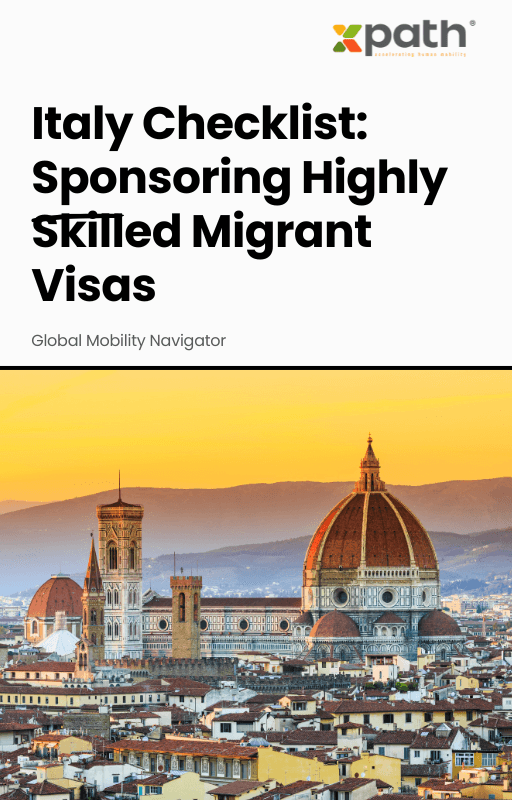Italy Checklist: Sponsoring Highly Skilled Migrant Visas
Grab a copy of a guide to international employee relocation
View E-bookOrganizations are increasingly leveraging global mobility to foster growth, tap into diverse talent pools, and expand into new markets. However, the intricacies of managing international assignments have long been a source of significant administrative burden for HR and global mobility teams. For far too long, the humble spreadsheet has served as the backbone of these operations. Yet, as the demands of a dynamic global workforce escalate, the limitations of this traditional approach are becoming painfully clear. The time has come for a strategic shift to modern global mobility technology.
While seemingly cost-effective on the surface, relying on spreadsheets for global mobility management conceals a multitude of hidden expenses that erode efficiency, increase risk, and hinder strategic decision-making:
Manual data entry is inherently prone to errors.A single mistyped visa expiry date or incorrect tax jurisdiction can lead to costly compliance failures, penalties, and severe disruptions to an assignee’s journey. With multiple versions circulating and no single source of truth, maintaining accurate and consistent data across an organization becomes a near-impossible feat.
HR professionals spend countless hours manually tracking details, chasing approvals, updating information, and generating reports. This administrative overhead diverts valuable time from strategic initiatives like talent development, workforce planning, and enhancing the employee experience.
Spreadsheets offer a static snapshot, making it incredibly difficult to gain real-time insights into the status of assignments, costs, or compliance risks.Without a centralized, dynamic view, proactive problem-solving and data-driven decision-making are severely hampered.
The ever-evolving landscape of immigration, tax, and labor laws across different countries presents a significant challenge. Relying on manual tracking means a heightened risk of missing critical deadlines for document renewals (like visas and permits), leading to potential legal repercussions, financial penalties, and disruptions to the assignment.
The manual, disjointed processes often translate into a fragmented and frustrating experience for assignees. Delays in information, lost documents, or unexpected issues can significantly impact their morale and productivity.
As the volume of international assignments grows, the complexity of spreadsheet management explodes. What might work for a handful of assignees becomes unmanageable for a burgeoning global workforce, limiting an organization’s ability to scale its mobility programs effectively.
The move from spreadsheets to strategic systems is no longer a luxury but a necessity for organizations committed to efficient, compliant, and employee-centric global mobility. Modern global mobility technology platforms offer a comprehensive solution that addresses the inherent limitations of manual processes, empowering HR and global mobility teams to become strategic partners.
Consider the transformative impact observed in companies that have successfully transitioned from manual to tech-driven mobility. These organizations often report significant reductions in administrative time, improved compliance rates, enhanced employee satisfaction, and a clearer understanding of the true cost and ROI of their global mobility programs. While specific case studies often remain confidential, the broad strokes of success echo across industries: a shift from reactive problem-solving to proactive strategic management.
Platforms like xpath.global exemplify the power of purpose-built technology in revolutionizing global mobility.xpath.global offers a robust suite of features designed to streamline and automate the entire international assignment lifecycle, freeing HR from the shackles of manual data entry and fragmented information.
Here’s how xpath.global specifically addresses the challenges faced by HR professionals:
Gone are the days of frantic, last-minute scrambles to renew critical documents. xpath.global’s automated expiry date reminders for visas, passports, and permits ensure timely renewals, significantly mitigating compliance risks and preventing costly assignment disruptions.HR teams can tailor reminder frequencies, providing ample lead time for necessary actions.
Ditching scattered spreadsheets, xpath.global provides a centralized and secure expatriate profile.This comprehensive digital hub consolidates all essential employee information – personal details, employment history, dependent information, and assignment-related documents – into a single, easily accessible location.This eliminates redundant data entry, ensures accuracy, and simplifies information retrieval for HR and service providers alike.
Managing diverseinternational assignments from short-term business travel to long-term expatriations becomes seamless with xpath.global’s dedicated assignment management features.The platform offers a unified overview of all assignments, allowing HR to visualize employee locations, track progress, manage benefit packages, and oversee costs in real-time. Hence empowering HR to make informed decisions and ensure a smooth experience for every assignee.
The complexities of global mobility often involve managing numerous interconnected tasks and stakeholders. xpath.global’s intuitive case management system acts as a central command center. It provides a detailed audit trail of all activities, tracks task completion, and facilitates seamless collaboration between HR, assignees, and a global network of vetted service providers. This enhanced transparency and accountability ensure that every aspect of an assignment is handled efficiently and effectively, minimizing delays and miscommunications.
By embracing platforms like xpath.global, HR departments can move beyond the administrative burden of traditional processes and truly leverage global mobility as a strategic asset. The shift from spreadsheets to sophisticated, integrated systems isn’t just about efficiency; it’s about empowering organizations to confidently navigate the complexities of international assignments, attract and retain top talent, and unlock new opportunities in the global marketplace.The future of global mobility is digital, streamlined, and strategically driven.

Italy Checklist: Sponsoring Highly Skilled Migrant Visas
Grab a copy of a guide to international employee relocation
View E-book